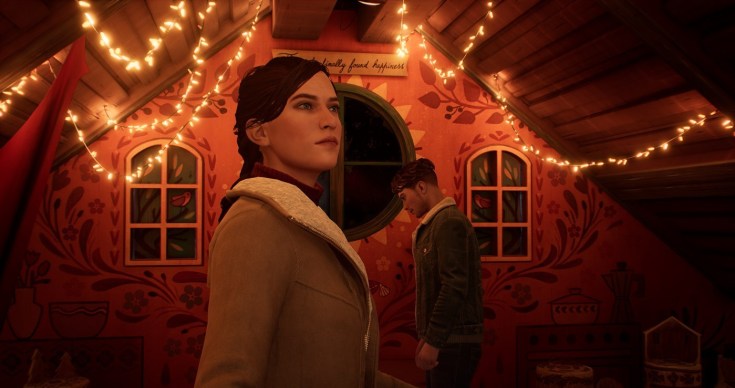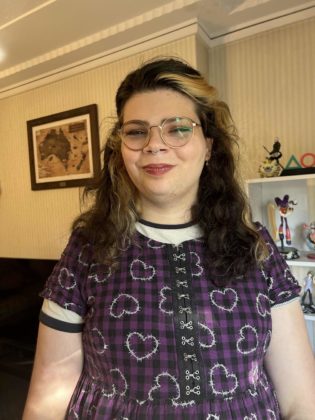Tell Me Why is French developer DONTNOD‘s latest title. Being one of the first AAA games to have a protagonist that’s trans isn’t the game’s only feat. It has a surprising depth about it when it comes to exploring characters with both mental illness and trauma. Additionally, its game mechanics are even used to explore the idea of an unreliable narrator in one of the best ways in recent memory. Let’s run through that, shall we?
This article contains large spoilers for all three episodes of Tell Me Why. If you’re planning on playing the game, maybe sit this one out and revisit this article once done.
This isn’t a review of Tell Me Why. If you’d like to hear our thoughts on that, go here. What I do want to explore in this article is the ways in which the game uses the twins’ relationship and shared ‘voice’ ability to explore a large variety of themes. Alyson and Tyler both went through some shit, and they carry quite the emotional baggage between them as a result. I mean for Christ’s sake, one of them killed their mother, Mary Ann. That’s got to carry some weight. Add ten years, a juvy rehabilitation sentence for Tyler, and a boatload of trauma, and the twins have a cocktail of issues they’ve got to work through.
There’s excellent story-telling and character development in Tell Me Why. In dialogue and shared important moments, we get quite a generous amount of time learning the difficulties that have come with the Ronan twins’ lives. However, this is also explored another way: through the game mechanic of the twins being able to relive shared memories. Throughout the first chapter of the game, we get a few examples of how some of these memories play out. In the Ronan’s home, we see the twins stare at a memory of a spectral-like version of themselves and their mother. In each memory, Mary Ann is fairly cold and distant. This isn’t a stretch for the audience to believe; we know their relationship with their mother was strained to say the least.
These memories all appear to the twins in the form of glowing silhouettes of earlier versions of themselves and other members in their lives. Yes, it’s all very Everybody’s Gone to the Rapture. There’s one very big difference, though. In Rapture, the visions are a depiction of past events, exactly the way they occurred. It’s not so simple as that in Tell Me Why. The twins’ visions are not of events, but of memories. And memories can be imperfect, biased, and influenced over time.
An ‘unreliable narrator’ is a narrative device in which the point-of-view character’s telling of the story is questionable in some way. Whether they are outright lying, mistaken, or confused, the story you’re being told isn’t the whole truth. Memento is a famous and popular film example, with its out-of-order editing always leaving you guessing. In video games, The Beginner’s Guide is a notable example. Tell Me Why plays it a little differently from these examples, however. You can choose which of the twins’ memories are real, and which twin is ‘misremembering’. But as we’ll soon come to learn, memories are almost never remembered perfectly, and can become distorted over time.

Conceptions vs Misconceptions
Tell Me Why is a game where you’ll have to trust your gut. With ten years between the disastrous events that led to their mother’s death and the current time in-game, memory is no doubt fuddled for the twins. The first important time this is really shown is when the two visit their local grocery store that Alyson also happens to work at. Here you’re introduced to the shop owners Tessa and Tom, who were both close friends of Mary Ann and significant parts of the twins’ lives. Perusing the aisles of the shop, a memory comes to them.
Alyson remembers the memory as Tessa being abrasive in the way she approaches Mary Ann in the shop, threatening to call in some of the debts she owes. Juxtaposing this, Tyler remembers this moment as Tessa approaching their mother cautiously, and Mary Ann being agitated, initiating an argument herself. When both these scenarios play out, Tylor chuckles a little, noting the difference in memory. He even goes as far as to reference Rashomon, a famous 1950’s Japanese film, known for creating a story with conflicting points of view.
Like Life is Strange before it, whatever version of events you choose to accept as truth doesn’t matter too much here. Either character will likely be a bit bummed you chose the opposing option for a bit, then move on. Still, it’s the first moment Tell Me Why is crystal clear in communicating that the events of the past ten years have affected the twins in different ways. In Tyler’s perspective, Mary Ann is more of an antagonist and vicious person than she is in Alyson’s book. One can assume that Tyler thinks this way because he is burdened by his mother’s feelings of him being a trans man… or what he thinks were her feelings. There, leaking through, is the complexities of a memory biased by trauma. It can poison the mind, making someone into a villain for some, or simply a troubled person for others.

I think what the game also does well is the variety in these lived memories. Sometimes, they’re little tidbits and small quirks from their childhood that aren’t quite remembered the same way. In others, they’re key events that have clearly affected the two both equally and hence are remembered exactly the same way by both twins. The biggest example of this type of memory is when Tyler insists on taking the fall for killing Mary Ann instead of the actual perpetrator, Alyson.
What’s special here is that Tell Me Why has really found a solid way to ‘gamify’ the unreliable narrator, making it not just part of the story but an actual game mechanic. It’s also similar enough to the choice-making you’ll find in Life is Strange that it feels like a natural progression; and a good one at that. More than in any other adventure mystery game, I found myself looking deeper within some of the decision making the game offered.
Developing and caring for characters in a limited time-frame
Despite being briefer than the usual DONTNOD game, containing only 3 chapters, I feel I got as acquainted as ever with its main characters more than ever. This is largely in part due to the wonderful writing that came both in-between these gameplay moments and those explored through dialogue and exposition. There’s a lot of tough, unpleasant exchanges and experiences the twins go through in solving the mystery of their mother. I’d argue most are quite appropriate in helping the characters grow and learn, and it even let me embrace the discomfort that can come from Tell Me Why.
In Chapter 2, Alyson and Tyler learn of the time Tessa reported Mary Ann to social services about the neglect the twins were suffering. The twins are angry at Tessa, and you later have the opportunity to decide whether or not the twins will forgive Tessa. At first, this is baffling. Tessa clearly was just looking out for the kids in this regard. Why are they angry? Take a moment to stew with this and it’s clear: it’s another excellent moment in exploring abuse and trauma in the game. Like in real life, victims of abuse can still harbour love for and defend their abusers. While not always of malicious and deliberate intent, neglect is abuse. There’s no perfect description or behaviours of a victim, just like there’s no perfect description or behaviours of an abuser (more on that later). Seeing them react like this is quite plausible. I understand Tyler and Alyson more than ever here.

Taking on challenges and accepting responsibility
“Tell Me Why is a game where you’ll have to trust your gut.”
At the end of Chapter 2, Alyson and Tyler find themselves in an argument. Tyler learns that, if the twins push hard enough, they can force the memory of Mary Ann’s death to reappear once more. Eager as ever to find more answers, Tyler pleads Alyson to follow, except she simply isn’t ready. Burdened with guilt and self-doubt about the potential reality of that night, she turns away.
Even if it’s essentially an event to bring about the big climax that is the next chapter, I really like this moment. It’s an interesting insight into the way that everyone grieves and deals with hardships in different ways. Tyler is eager to learn more about that fateful night. But of course, he wasn’t the one who actually killed Mary Ann. It’s likely easier for him to think back to and reflect on that night. Naturally, Alyson isn’t in the same boat.
Now we’ve hit the conclusion of Tell Me Why. We’ve had quite a bit of Mary Ann’s story explored, including even some humanising moments such as the transgender child support book we find in her room, or the little moments of her dancing and hanging out with her kids, creating stories together. Now, however, it’s really her time.
With Tyler and Alyson making up and now reunited, it’s here we learn the backstory of Mary Ann and how she came to be. A difficult teenage life, need to escape her parents, and an unplanned pregnancy is what brought her to Delos Crossing. Money challenges, a miscarriage, isolation and so much more is what made her the way she was on the night of her passing. An excellent job is done here in explaining Mary Ann’s reasoning for being so absent and neglectful from her kids: she was wrought with mental health issues. At the same time, a just as excellent job is done in not excusing it. As stated earlier, abuse is abuse, even if it’s not of malicious intent.
Fast forward a bit and we get the last, pivotal shifting moment of the game. Tessa’s husband Tom has been revealed to have been the twins’ father in secret all along. He confesses he was there on the night of Mary Ann’s death and witnessed the whole thing. He makes a big claim, stating that at the most, Mary Ann was just going to commit suicide and didn’t want to hurt Tyler. The shotgun she’s holding in all those flashbacks was never intended for her son, only herself. She loved and cared for her kids, and was just barred from showing it enough because of her mental illness.
Here’s where players are faced with the most difficult decision of Tell Me Why. The twins stand on the dock, two choices ahead of them. Was the killing of Mary Ann self-defence or not? Tyler affirms everything that the narrative has been telling us the whole time: of course it was self-defence. Alyson has her doubts, and is leaning more into the guilt that plagues her mind: maybe she made a horrible mistake all those years ago. Before deciding, Tyler assures Alyson he’ll support her no matter the outcome. Maybe he too has his doubts, but wants to stick to the story to defend Alyson? That, and like so many other parts of Tell Me Why, we’ll never know.
This ending choice is excellent in tying together the gameplay knot of the unreliable narrator, as well as the themes of abuse and trauma. Depending on the walks of your life, people could really swing either way. Mary Ann did some horrible things to the twins. Of course it was self-defence. All those breadcrumbed shadows of doubt though… could it have ended differently? The answer is up to you, but it will never be simple. There’s no wrong answer here, just a lesson in the difficulties of trauma, how much it can warp your memory, and how much it can warp everything you think you know. In the end, you’ll have your own truth.
With a few weeks now removed for the dust to settle, I think Tell Me Why will sit with the right people for quite a long time, for the right reasons. It has so much to say about complex relationships and how to explore them and deal with them. More so than any other game I’ve seen for a while.
If you’re keen on more Tell Me Why coverage, check out our podcast interview where fellow Checkpoint writer Hailey and I chat with Morgan Lockhart and Clay Carmouche, two key narrative and writing staff on the game, about some of the ins and outs of this complex adventure.





